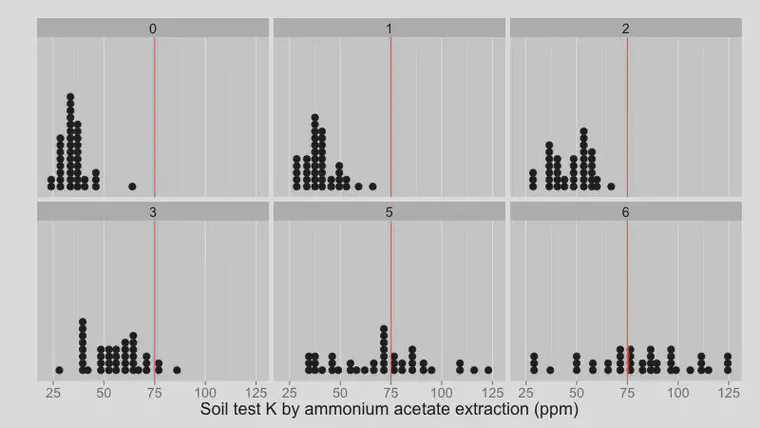Rapid declines in soil test potassium
Phil Busey shared a chart and discussion that shows just how fast soil potassium (K) can decline. A calcareous sand rootzone with soil test K of 39 ppm was fertilized with 5 pounds of K2O per 1000 ft2 [25 g K2O m-2]. That’s a lot of K in a single application.
Not surprisingly, the soil test K went up. 6 days after the application, the soil K was up to 153 ppm. However, the soil K went down again pretty quickly; by 45 days after the application, the soil K was all the way back down to 44 ppm, as if no fertilizer had been applied at all.
The soil test used was the ammonium acetate extraction, which Carrow et al. suggest should be at 75 ppm K (or more) in a sand rootzone. But as Busey’s chart shows so well, the soil can certainly be increased to more than 75 ppm, but it doesn’t last.
In an experiment on a calcareous sand green, I applied K fertilizer at six rates – 0, 1, 2, 3, 5, and 6 g K/m2/14 days. In 2002 I made 13 applications and in 2003 I made 12 applications. From the start of the experiment on 4 June 2002 until the final soil testing 2 years later on 30 May 2004, there were a total of 10 soil testing events. There were 4 replications of each K fertilizer treatment, so in total there were 40 soil tests for each fertilizer rate.
This dot plot shows the test results, separated by fertilizer rate, with each dot representing a single soil test. A red vertical line is placed at the 75 ppm mark, to more easily identify which of the soil tests had a value more than the conventional guideline of 75 ppm.

It was only in the plots receiving at least 5 g K m-2 (1 pound K/1000 ft2) every 2 weeks during the growing season in which the soil test K would sometimes reach the conventional guideline of 75 ppm. However, no matter the level of soil test K, above or below the conventional guideline of 75 ppm, the turf quality was excellent.
It is this type of result that led to the development of the MLSN guidelines. Conventional soil test guidelines are sometimes just impossible to reach. This is especially true in sand rootzones, which have a low cation exchange capacity.